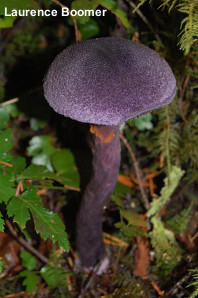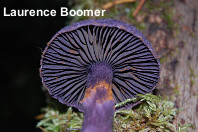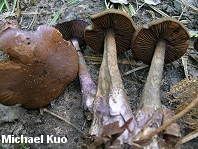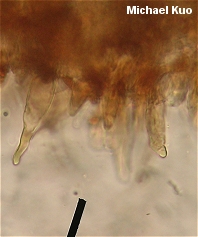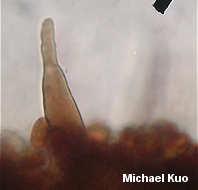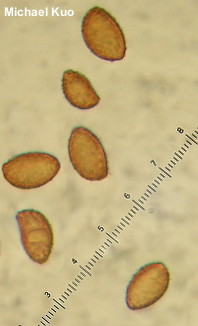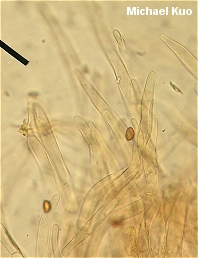| Major Groups > Gilled Mushrooms > Dark-Spored > Cortinarius > Cortinarius violaceus |

|
Cortinarius violaceus [Basidiomycota > Agaricales > Cortinariaceae > Cortinarius ... ] by Michael Kuo I must have some kind of dysfunction when it comes to charismatic, gorgeous mushrooms. It seems like I only find them when they are past their prime, looking nothing like they're "supposed to." Take Cortinarius violaceus, which is a beautiful deep purple species—a fact immediately in evidence in Laurence Boomer's photos to the right, representing a collection he made and sent to me. Now look at my photo. Sigh. I have found this mushroom twice: once as the decrepit, no-longer-purple thing you're looking at, and once a decade earlier in the same location, when it was gorgeous and thrilling—but before I owned a camera. Cortinarius violaceus features a dry, scaly cap and a dry, finely hairy stem, both of which—along with the young gills—are deep purple when fresh (ahem). Microscopic features for the species are even more distinctive, however: it is the only species in the genus Cortinarius that features prominent, clearly defined cystidia on its gills. According to some authors, Cortinarius violaceus should be divided into two varieties (or subspecies, or species, depending on the author): var. violaceus, associating with various hardwoods and featuring amygdaliform spores—and var. hercynicus, associating with conifers and featuring ellipsoid spores. In my experience these differences are not consistent. Thanks to Laurence Boomer for collecting, documenting, and preserving some of the illustrated and described specimens; his collection is deposited in The Herbarium of Michael Kuo. Description: Ecology: Mycorrhizal with hardwoods or conifers; in western North America often reported as appearing in old-growth conifer forests near rotting logs; growing alone, scattered, or gregariously; fall; apparently widely distributed in North America. The illustrated and described collections are from Michigan and Oregon. Cap: 4–12 cm; convex, becoming broadly convex, nearly flat, or slightly bell-shaped; dry; densely hairy, becoming fuzzy or scaly; deep purple, becoming brownish purple and eventually dark brown overall. Gills: Attached to the stem; nearly distant; dark purple at first, becoming grayish to blackish, and eventually rusty brown; covered by a purple cortina when young. Stem: 6–16 cm long; up to 2 cm thick; equal above a swollen or club-shaped base; dry; purple and finely hairy when young, becoming purplish gray to nearly black or brown, with a sheen; dry; becoming hollow. Flesh: Purple to lilac or purplish gray. Odor: Sweet and slightly fragrant, or not distinctive. Chemical Reactions: KOH red on cap surface and on flesh. Spore Print: Rusty brown. Microscopic Features: Spores 11.5–14.5 (–18) x 7–9 µm; ellipsoid to amygdaliform; moderately verrucose. Cheilo- and pleurocystidia fusoid-ventricose with a long neck, or sometimes irregularly cylindric; with purple to reddish contents in a KOH mount when fresh, but with brown contents after drying; up to about 80 x 25 µm. Pileipellis a cutis with fascicles of upright elements. REFERENCES: (Linnaeus, 1753) S. F. Gray, 1821. (Fries, 1821; Saccardo, 1887; Kauffman, 1918; Kauffman, 1932; Smith, Smith & Weber, 1979; Moser, 1983; Arora, 1986; Phillips, 1991/2005; Hansen & Knudsen, 1992; Lincoff, 1992; Barron, 1999; Breitenbach & Kränzlin, 2000; McNeil, 2006; Miller & Miller, 2006; Trudell & Ammirati, 2009; Kuo & Methven, 2014; Desjardin, Wood & Stevens, 2015; Evenson, 2015; Siegel & Schwarz, 2016.) Herb. Kuo 09049403, 09110510, 10231304. This site contains no information about the edibility or toxicity of mushrooms. |
© MushroomExpert.Com |
|
Cite this page as: Kuo, M. (2017, May). Cortinarius violaceus. Retrieved from the MushroomExpert.Com Web site: http://www.mushroomexpert.com/cortinarius_violaceus.html |
